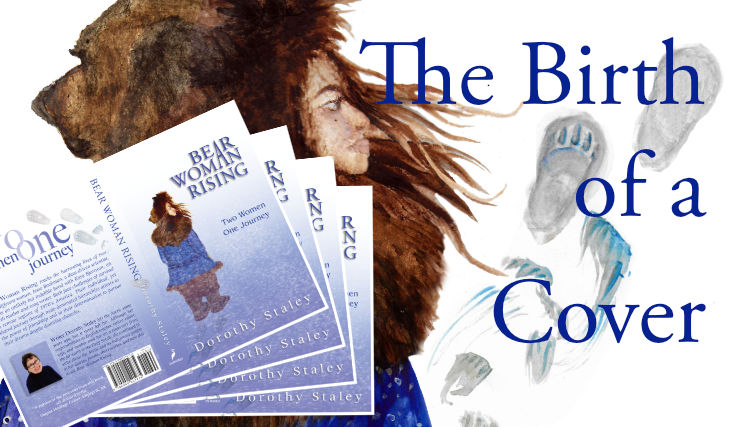Knowing the importance of first impressions, my daughter Laurie and I began discussing cover ideas for Bear Woman Rising in the fall of 2019. Although I had helped design covers for government publications, my experience was limited. But Laurie, a published author in her own right,* had worked with a wide range of cover designers and artists, and I welcomed her input. Our first challenge was to choose a cover image for my book.
Growing up in Barrow, Laurie wanted to be just like her village friends. When she was in 2nd grade, she came to me in tears because her hair was blonde, not black. While she quickly learned to blend, I spent my days interviewing scientists at the arctic research lab 5 miles north of the village. I managed to visit Barrow whenever I could to participate in whaling feasts, traditional games and dances, and village meetings. But my many visits couldn’t replicate Laurie’s full time immersion in the Iñupiat community. Her daily exposure to village life as a young girl was key to her appreciation of Iñupiat culture as a grown woman.
Although 4 decades had passed since we left the Arctic, Laurie never forgot the many villagers who shaped her childhood. She was determined to find an Iñupiat artist to create a cover image that would authentically reflect our chosen bear woman myth.
An Eskimo man and woman fight at hunting camp. He slaps her and she runs away. The next day he goes to find her. Before he can say he’s sorry, she rears up and turns into a bear. The bear is wearing her parka. She brushes away the bear skin from her face and underneath is her human face. She says, “Now you want to fight?”
We began our search by promoting a cover art competition through the University of Alaska’s Native Art Center in Fairbanks. Although we received considerable support from the Art Center’s staff, we were unsuccessful in attracting any student applicants.
Laurie was not ready to give up, but I was discouraged. After spending a decade writing and rewriting my book, I was anxious to cross the finish line. So I convinced her that it wasn’t necessary to work with someone familiar with the Arctic, and contacted an artist closer to home whose work showed potential. In a few short weeks, however, it became clear that we weren’t in sync. Her cover art included mountains and trees even after I had explained that neither existed on the North Slope. To her credit, she researched Inuit women’s parkas online but came up with an image typical of those worn in Canada rather than northern Alaska. Ultimately, I realized her vision and mine were never going to match. I was ready to renew our search for an Iñupiat artist.
After contacting several museums and colleges in Alaska to no avail, I remembered a little girl, Colleen Akpik, one of Laurie’s childhood friends. It seemed a long shot, but I hoped not only to find her, but that she might remember Laurie. So I googled, Colleen Akpik, her age, Barrow, Alaska. As luck would have it, her name popped up as Colleen Akpik-Lemen, Deputy Director of the Iñupiat Heritage Center in Barrow. Bingo! She was not only still there, but managing a center whose mission is to preserve Iñupiat culture.
I picked up the phone and called her. When I heard her voice, I was so excited I could hardly breathe. She not only remembered Laurie, she told me she’d just been reminiscing about our family. So after bringing her up to date on Laurie’s life, I told her I needed her help to find an Iñupiat artist to illustrate the cover of my book. She immediately said, “I have two artists in mind. Let me get back with you.” She did and by Christmas, Laurie and I began working with Britt’Nee Kivliqtaruq Brower, a 22 year old artist living in Anchorage, who had family ties to Barrow.
From December through April, Britt’Nee, Laurie and I communicated long distance to achieve the bear woman image I envisioned. The process involved continuous emails between the three of us. We would suggest a change, she would incorporate our suggestion, and we’d determine whether or not it worked. Most importantly, I relied on her personal understanding of Iñupiat mythology to create an authentic and engaging bear woman image. At one point, she literally went the extra mile by photographing fresh polar bear foot prints in the snow near Barrow to authenticate her depiction of bear prints on the cover.
Throughout the months of collaboration, Inword Publisher’s design expert, Bhakti-rasa, proposed numerous styles for the title, back ground, placement of the bear woman image, polar bear foot prints, and back cover information. As a title is the most important element on any cover, we spent weeks reviewing numerous typefaces, fonts, sizes, colors and placements of the words Bear Woman Rising before one we all loved surfaced. Full disclaimer, Bhakti-rasa came up with the brilliant teaser subtitle, Two Women One Journey.
Looking back, the free exchange of ideas and the mutual respect between author, artist and designer culminated in the birth of our final cover. The “aha” moment we all shared when Inword Publishing delivered Bear Woman Rising was well worth the nine month gestation period.
______
*China CEO II: Voices of Experience by Juan Antonio Fernandez and Laurie Underwood. 2020, John Wiley & Sons.



